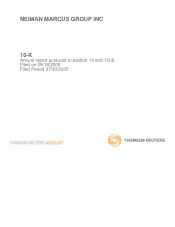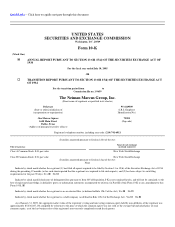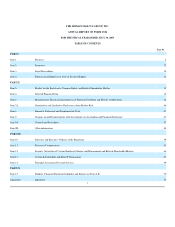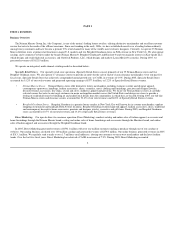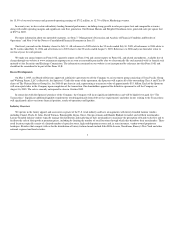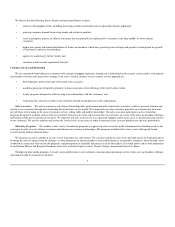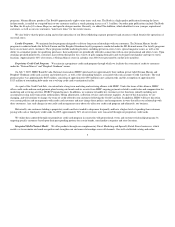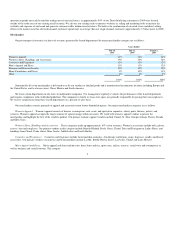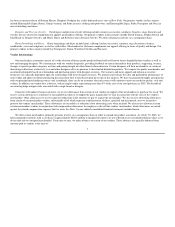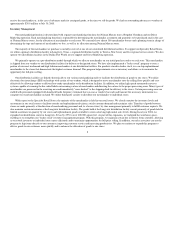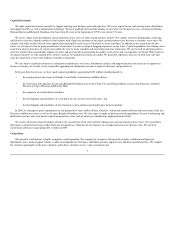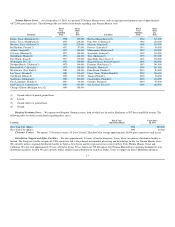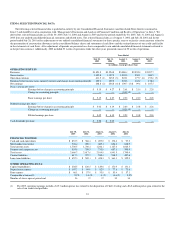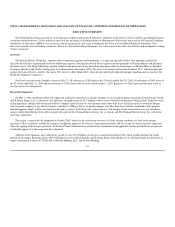Neiman Marcus 2004 Annual Report Download - page 11
Download and view the complete annual report
Please find page 11 of the 2004 Neiman Marcus annual report below. You can navigate through the pages in the report by either clicking on the pages listed below, or by using the keyword search tool below to find specific information within the annual report.
receive the merchandise or, in the case of advances made for consigned goods, at the time we sell the goods. We had net outstanding advances to vendors of
approximately $24.6 million at July 30, 2005.
Inventory Management
Our merchandising function is decentralized with separate merchandising functions for Neiman Marcus stores, Bergdorf Goodman and our Direct
Marketing operation. Each merchandising function is responsible for determining the merchandise assortment and quantities to be purchased and, in the case
of Neiman Marcus stores, for the allocation of merchandise to each store. We currently have almost 300 merchandise buyers and a planning team in charge of
determining the type and amount of merchandise we buy, as well as its allocation among Neiman Marcus stores.
The majority of the merchandise we purchase is initially received at one of our centralized distribution facilities. To support our Specialty Retail Stores,
we utilize a primary distribution facility in Longview, Texas, a regional distribution facility in Totowa, New Jersey and five regional service centers. We also
operate two distribution facilities in the Dallas-Fort Worth area to support our Direct Marketing operation.
We primarily operate on a pre-distribution model through which we allocate merchandise on our initial purchase orders to each store. This merchandise
is shipped from our vendors to our distribution facilities for delivery to designated stores. We have also implemented a "locker stock" program to store a
portion of our most in-demand and high fashion merchandise at our distribution facilities. For products stored in locker stock, we can ship replenishment
merchandise to the stores that demonstrate the highest customer demand. This program helps minimize excess inventory and allows us to maximize the
opportunity for full-price selling.
Our distribution facilities are linked electronically to our various merchandising staffs to facilitate the distribution of goods to our stores. We utilize
electronic data interchange (EDI) technology with certain of our vendors, which is designed to move merchandise onto the selling floor quickly and cost-
effectively by allowing vendors to deliver floor-ready merchandise to the distribution facilities. In addition, we utilize high-speed automated conveyor
systems capable of scanning the bar coded labels on incoming cartons of merchandise and directing the cartons to the proper processing areas. Many types of
merchandise are processed in the receiving area and immediately "cross docked" to the shipping dock for delivery to the stores. Certain processing areas are
staffed with personnel equipped with hand-held radio frequency terminals that can scan a vendor's bar code and transmit the necessary information to a
computer to record merchandise on hand. We utilize third-party carriers to distribute our merchandise to individual stores.
With respect to the Specialty Retail Stores, the majority of the merchandise is held in our retail stores. We closely monitor the inventory levels and
assortments in our retail stores to facilitate reorder and replenishment decisions, satisfy customer demand and maximize sales. Transfers of goods between
stores are made primarily at the direction of merchandising personnel and, to a lesser extent, by store management primarily to fulfill customer requests. We
also maintain certain inventories at the Longview distribution facility. The goods held at the Longview distribution facility consist primarily of goods held in
limited assortment or quantity by our stores and replenishment goods available to stores achieving high initial sales levels. During fiscal year 2004, we
expanded our distribution center in Longview, Texas by 25% to over 600,000 square feet. As part of this expansion, we realigned the warehouse space,
enabling us to strengthen our "locker stock" inventory management program. With this program, we maintain certain key inventory items centrally, allowing
us to restock inventory at individual stores more efficiently and to maximize opportunities for full-price selling. In addition, our sales associates can use the
program to ship items directly to our customers, improving customer service and increasing productivity. We plan to continue to expand this program to
deliver goods to our customers more quickly and to enhance the allocation of goods to our stores.
8

